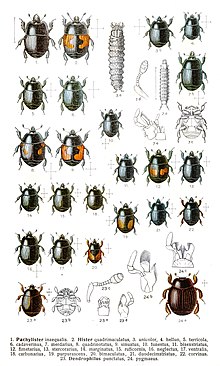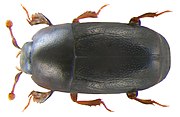
Forensic entomology is the scientific study of the colonization of a dead body by arthropods. This includes the study of insect types commonly associated with cadavers, their respective life cycles, their ecological presences in a given environment, as well as the changes in insect assemblage with the progression of decomposition. Insect succession patterns are identified based on the time a given species of insect spends in a given developmental stage, and how many generations have been produced since the insects introduction to a given food source. Insect development alongside environmental data such as temperature and vapor density, can be used to estimate the time since death, due to the fact that flying insects are attracted to a body immediately after death. The identification of postmortem interval to aid in death investigations is the primary scope of this scientific field. However, forensic entomology is not limited to homicides, it has also been used in cases of neglect and abuse, in toxicology contexts to detect the presence of drugs, and in dry shelf food contamination incidents. Equally, insect assemblages present on a body, can be used to approximate a given location, as certain insects may be unique to certain areas. Therefore, forensic entomology can be divided into three subfields: urban, stored-product and medico-legal/medico-criminal entomology.

Silphidae is a family of beetles that are known commonly as large carrion beetles, carrion beetles or burying beetles. There are two subfamilies: Silphinae and Nicrophorinae. Nicrophorines are sometimes known as sexton beetles. The number of species is relatively small at around two hundred. They are more diverse in the temperate region although a few tropical endemics are known. Both subfamilies feed on decaying organic matter such as dead animals. The subfamilies differ in which uses parental care and which types of carcasses they prefer. Silphidae are considered to be of importance to forensic entomologists because when they are found on a decaying body they are used to help estimate a post-mortem interval.

A maggot is the larva of a fly ; it is applied in particular to the larvae of Brachycera flies, such as houseflies, cheese flies, and blowflies, rather than larvae of the Nematocera, such as mosquitoes and crane flies.

Trogidae, sometimes called hide beetles, is a family of beetles with a distinctive warty or bumpy appearance. Found worldwide, the family includes about 300 species contained in four or five genera.

Dermestidae are a family of Coleoptera that are commonly referred to as skin beetles. Other common names include larder beetle, hide or leather beetles, carpet beetles, and khapra beetles. There are over 1,800 species described.

Cleridae are a family of beetles of the superfamily Cleroidea. They are commonly known as checkered beetles. The family Cleridae has a worldwide distribution, and a variety of habitats and feeding preferences.

Histeroidea is a superfamily of beetles in the infraorder Staphyliniformia.
Forensic entomological decomposition is how insects decompose and what that means for timing and information in criminal investigations. Medicolegal entomology is a branch of forensic entomology that applies the study of insects to criminal investigations, and is commonly used in death investigations for estimating the post-mortem interval (PMI). One method of obtaining this estimate uses the time and pattern of arthropod colonization. This method will provide an estimation of the period of insect activity, which may or may not correlate exactly with the time of death. While insect successional data may not provide as accurate an estimate during the early stages of decomposition as developmental data, it is applicable for later decompositional stages and can be accurate for periods up to a few years.

Phormia regina, the black blow fly, belongs to the blow fly family Calliphoridae and was first described by Johann Wilhelm Meigen.
In forensic entomology, entomotoxicology is the analysis of toxins in arthropods that feed on carrion. Using arthropods in a corpse or at a crime scene, investigators can determine whether toxins were present in a body at the time of death. This technique is a major advance in forensics; previously, such determinations were impossible in the case of severely decomposed bodies devoid of intoxicated tissue and bodily fluids. Ongoing research into the effects of toxins on arthropod development has also allowed better estimations of postmortem intervals.

Nicrophorus orbicollis is a nearctic burying beetle first described by Thomas Say in 1825. It is a member of the genus Nicrophorus or sexton beetles, comprising the most common beetles in the family Silphidae. This species is a decomposer feeding on carcasses of small dead animals. N. orbicollis can be used for scientific research both medically and forensically.
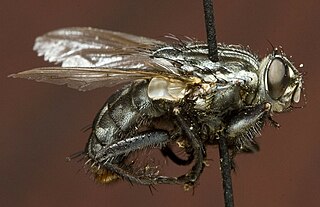
Sarcophaga bullata, or the grey flesh fly, is a species of fly belonging to the family Sarcophagidae. It varies in size from small to large, 8 to 17 millimeters in length and is very similar in appearance and behavior to a closely related species, Sarcophaga haemorrhoidalis. S. bullata is a common scavenger species in the Eastern United States, but is found throughout the Nearctic region. Identification down to the species level in the family Sarcophagidae is notably difficult and relies primarily on the male genitalia. Though limited information is available regarding S. bullata, it has gained increasing recognition in the field of forensic entomology as a forensically relevant fly species, as it may be among the first species to colonize human remains. In these instances, recovered maggots may be analyzed for post-mortem interval (PMI) estimations, which may be used as evidence in courts of law. Current studies regarding S. bullata have revealed a maternal effect operating in these flies that prevents pupal diapause under certain environmental conditions, which is an important factor to be considered during forensic analyses.

Fannia scalaris, also known as the latrine fly, is a fly species in the Fanniidae family. This species is smaller and more slender than the house fly, Musca domestica, and is similar in appearance to the lesser house fly, Fannia canicularis. The life cycle of this species can be as long as one month. These flies are globally distributed in urban areas as they are drawn to unsanitary environments. F. scalaris is a major cause of myiasis, the infestation of a body cavity by fly maggots. The adults infest bodies that have decomposed, making the species an important part of forensic entomology. The larvae of this fly have adapted protuberances, or feathered appendages, that allow them to survive in such a moist environment. Entomologists continue to research the effects that F. scalaris may have medically, forensically, and on the environment around them.
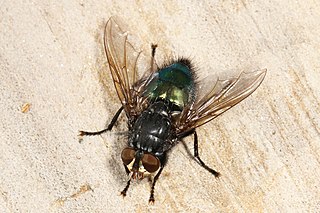
Cynomya cadaverina, also known as the shiny blue bottle fly, is a member of the family Calliphoridae, which includes blow flies as well as bottle flies. In recent years, this family has become a forensically important facet in many medicocriminal investigations in the growing field of forensic entomology. C. cadaverina is specifically important in determining a post-mortem interval, as well as other important factors.

Synthesiomyia nudiseta is one of the largest flies in the family Muscidae. The fly has a pair of forewings; the paired hind wings have been reduced to halteres that help with stability and movement during flight. Key characteristics of this species include plumose segmented aristae, well-developed calypters, and sternopleural bristles. Synthesiomyia nudiseta is a forensically important species because it is necrophilous and can therefore help determine the time of colonization for the post mortem interval with its known life cycle.

Creophilus maxillosus, the hairy rove beetle, is a species of rove beetle.

Oiceoptoma noveboracense is a member of the family Silphidae, or carrion beetles, which feed on decaying organic matter such as dead animals. Its common name is the margined carrion beetle, from the orange-red margins on the pronotum, which are helpful when identifying this species. The larva is typically light brown to red and also has vertical ridges on its thorax like the adult. This diurnal beetle can be found mainly in the spring into the fall, and it has a strong preference towards a deciduous forest habitat. The primary forensic importance of this beetle is its ability to use the succession of insect fauna to provide confirmation of postmortem intervals.
Calliphora loewi is part of the family Calliphoridae, bottle flies and blowflies, and in the genus Calliphora, blue bottle flies. The genus can be deceiving since C. loewi is not blue. Though this species is rare, it can play an important part in forensic entomology, spreading disease, and decomposing carrion. The life cycle of C. loewi is similar to the life cycle of the genus Calliphora. Since this species is rare there has not been very much research done with this species.
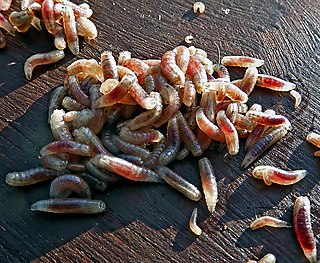
Carrion insects are insects associated with decomposing remains. The processes of decomposition begin within a few minutes of death. Decomposing remains offer a temporary, changing site of concentrated resources which are exploited by a wide range of organisms, of which arthropods are often the first to arrive and the predominant exploitive group. However, not all arthropods found on or near decomposing remains will have an active role in the decay process.

Necrophages are organisms that obtain nutrients by consuming decomposing dead animal biomass, such as the muscle and soft tissue of carcasses and corpses. The term derives from Greek nekros, meaning 'dead', and phagein, meaning 'to eat.' Mainly, necrophages are species within the phylum Arthropoda; however, other animals, such as gastropods and Accipitrimorphae birds have been noted to engage in necrophagy.
